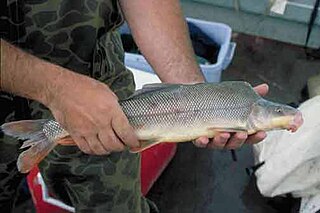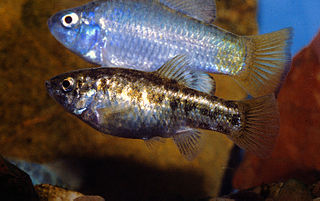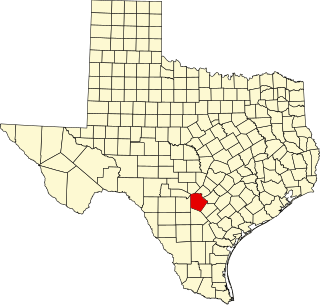
The United States Fish and Wildlife Service, also known by the acrnonyms USFWS or FWS, is an agency within the United States Department of the Interior dedicated to the management of fish, wildlife, and natural habitats. The mission of the agency is "working with others to conserve, protect, and enhance fish, wildlife, plants and their habitats for the continuing benefit of the American people."

The loach minnow is a species of freshwater fish. It is a member of the carp family of order Cypriniformes. It occurs in streams and small rivers throughout the Gila River and San Pedro River systems in Arizona, New Mexico, and Sonora; it is now considered extinct in Mexico.

The Devils Hole pupfish is a critically endangered species of the family Cyprinodontidae (pupfishes) found only in Devils Hole, a water-filled cavern in the US state of Nevada. It was first described as a species in 1930 and is most closely related to C. nevadensis and the Death Valley pupfish. The age of the species is unknown, with differing analyses offering ranges between one thousand and sixty thousand years. It is a small fish, with maximum lengths of up to 30 mm (1.2 in). Individuals vary in coloration based on age and sex: males are bright metallic blue while females and juveniles are more yellow. A defining trait of this species is its lack of pelvic fins. The pupfish consumes nearly every available food resource at Devils Hole, including beetles, snails, algae, and freshwater crustaceans, with diet varying throughout the year. It is preyed on by the predaceous diving beetle species Neoclypeodytes cinctellus, which was first observed in Devils Hole in 1999 or 2000. Reproduction occurs year-round, with spikes in the spring and fall. Females produce few eggs, though, and the survivorship from egg to adult is low. Individuals live 10–14 months.

The shortnose sucker is a rare species of fish in the family Catostomidae, the suckers. This fish is native to southern Oregon and northern California in the United States. It is a federally listed endangered species of the United States.
The Maryland darter is a species of freshwater ray-finned fish, a darter from the subfamily Etheostomatinae, part of the family Percidae, which also contains the perches, ruffes and pikeperches. It is considered one of the rarest freshwater fish species in the world, due in part to its incredibly limited geographic range and difficulty of detection. The last sighting of one was in 1988. The Maryland darter is named after the only state in which it is known to occur. The species was long known only by two specimens until being "re-discovered" in 1962. From 1965 into the 1980s, the species was believed to have been confined to a single riffle in Deer Creek. Possible explanations for the decline of the species center around widespread habitat degradation and reduction in water quality resulting from increasing rates of urbanization within the watershed. While the IUCN has declared the species extinct, the United States Fish and Wildlife Service has not, and keeps it on the Endangered Species List.

The Seney National Wildlife Refuge is a managed wetland in Schoolcraft County in the U.S. state of Michigan. It has an area of 95,212 acres (385 km2). It is bordered by M-28 and M-77. The nearest town of any size is Seney, Michigan. The refuge contains the Seney Wilderness Area and the Strangmoor Bog National Natural Landmark within its boundaries.

The razorback sucker is a suckerfish found in rivers and lakes in the southwestern United States and formerly northwestern Mexico. It can grow to 91 cm (3 ft) in length and is recognisable by the keel between its head and dorsal fin. It used to inhabit much of the Colorado River Basin but commercial fishing, river damming, and habitat loss have caused great declines in populations. It is now restricted to the Colorado River upstream of the Grand Canyon and to four reservoirs, Lake Mead, Lake Mohave, Lake Havasu, and Lake Powell.

The bonytail chub or bonytail is a cyprinid freshwater fish native to the Colorado River basin of Arizona, California, Colorado, Nevada, New Mexico, Utah and Wyoming in the southwestern United States; it has been extirpated from the part of the basin in Mexico. It was once abundant and widespread in the basin, its numbers and range have declined to the point where it has been listed as endangered since 1980 (ESA) and 1986 (IUCN), a fate shared by the other large Colorado basin endemic fish species like the Colorado pikeminnow, humpback chub, and razorback sucker. It is now the rarest of the endemic big-river fishes of the Colorado River. There are 20 species in the genus Gila, seven of which are found in Arizona.
The Barrens topminnow is an endangered species of freshwater fish in the family Fundulidae. There are many potential causes of decline of this species including the invasive western mosquitofish that will replace native species on a population level, wading piscivorous birds that prey on adults, and the overall restricted distribution of the species. Managing for this species is vital for its success, but to do so there must be an understanding of the species' characteristics. It is endemic to a small portion of Tennessee in the Elk River and West Hickory Creek in the Cumberland River drainage. The life span of F. julisia is very short, living up to only 3 years. In many cases the majority of the population does not even reach that age. Most adult males are eaten by birds because of their bright coloration during breeding season. Current management plans are in place for the improvement of the species such as captive breeding and reintroduction, and also private management of streams and land. Yet, more can be done to aid them in their survival efforts. Buffer zones around streams can be created to promote the health of the stream and close observation of the introduced populations needs to be a priority. With only three small original populations left in the wild it is important that species survive in captivity, but more so in its natural environment.

Astragalus pycnostachyus var. lanosissimus, the Ventura marsh milk-vetch, is a short-lived, herbaceous perennial in the pea family Fabaceae,

The copperbelly water snake or copperbelly is a subspecies of nonvenomous colubrid snake endemic to the Central United States.

The desert pupfish is a rare species of bony fish in the family Cyprinodontidae. It is a small fish, typically less than 7.62 cm (3 in) in length. Males are generally larger than females, and have bright-blue coloration, while females and juveniles are silvery or tan. A notable attribute of the desert pupfish is their ability to survive in environments of extreme salinity, pH, and temperature, and low oxygen content. The desert pupfish mates in a characteristic fashion, wherein compatible males and females will come in contact and collectively jerk in an s-shape. Each jerk typically produces a single egg that is fertilized by the male and deposited in his territory. Breeding behavior includes aggressive arena-breeding and more docile consort-pair breeding.

The Mount Graham red squirrel is an endangered subspecies of the southwestern red squirrel native to the Pinaleño Mountains of Arizona. It is smaller than most other subspecies of red squirrel, and also does not have the white-fringed tail that is common to the species. Its diet consists mainly of mixed seeds, conifer cones and air-dried fungi. It exhibits similar behavior to other squirrels in its species.

The Bay checkerspot is a butterfly endemic to the San Francisco Bay region of the U.S. state of California. It is a federally threatened species, as a subspecies of Euphydryas editha.

Stygoparnus is a monotypic genus of beetles containing the single species Stygoparnus comalensis, which is known by the common name Comal Springs dryopid beetle. This rare beetle is endemic to Texas in the United States, where it is known from two springs. It is a federally listed endangered species of the United States.

Heterelmis comalensis is a rare species of beetle known by the common name Comal Springs riffle beetle. It is endemic to Texas in the United States, where it occurs in only two springs. It is a federally listed endangered species of the United States.
Heterelmis glabra is a species of riffle beetle in the family Elmidae. It is found in Central America and North America. The largest populations of this riffle beetle are found in springs associated with the upper Devils River in south-central Texas. Spring-adapted organisms such as this beetle have life-history patterns requiring surface components, which makes them more vulnerable to changes in spring flow that alter the surface habitat.

Rhadine infernalis is a species of troglobitic beetle of the family Carabidae. They are endemic to the county of Bexar, Texas. Within this county, R. infernalis has been found in 39 caves. There are 2 named subspecies of R. infernalis: R. infernalis infernalis and R. infernalis ewersi. There is a third possible subspecies that has not been officially described. R. infernalis was classified in 2000 as endangered under the IUCN Endangered Species Act of 1973, along with 8 other karst invertebrates in the same region. It has the widest known range of the endangered karst invertebrates.
Zaitzevia thermae, also called the warm springs zaitzevian riffle beetle, is a flightless, wingless small beetle found in aquatic habitats in Montana.

Habroscelimorpha dorsalis dorsalis, commonly known as the northeastern beach tiger beetle, is the largest subspecies of eastern beach tiger beetle. In 2012, Cicindela dorsalis dorsalis was reclassified under the name Habroscelimorpha dorsalis dorsalis, but the names are used synonymously in recently published literature. Fitting to its common name, the northeastern beach tiger beetle dwells along the U.S. northeast coast in small sand burrows. The beetle is diurnal and can be spotted by its light tan coloring with dark lines and green hues on its thorax and head.

















